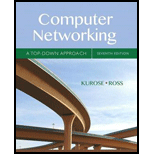
Application Layer:
Application layer provides the ability to access the network to a user. It includes the information of interfaces and helps in managing the
Transport Layer:
Transport layer is used for transferring the data or messages between the nodes and the devices. The data is sent in the form of blocks or segments. It is used to establish the end-to-end connection between the source and the destination.
Network Layer:
Network layer is provides the path in which the data packets are transferred from the source to the destination. It also helps in converting the logical or IP address to physical or Media Access Control (MAC) address.
Link Layer:
Link layer is the aggregation of procedures and protocols used in a link to share the data between the nodes. It includes mainly three functions namely, detection of transmission errors, regulation of data flow and provides well-structured interface.
Want to see the full answer?
Check out a sample textbook solution
Chapter 1 Solutions
Computer Networking: A Top-Down Approach (7th Edition)
- Page: 4 Task: 1. Compare and contrast BFS and DFS based on their implementation details in the file. 2. Propose modifications for better performance in unweighted graphs. 3. Discuss scenarios where greedy search outperforms A*. Link: https://drive.google.com/file/d/1wKSrun-GlxirS31Z9qoHazb9tC440AZF/view?usp=sharingarrow_forwardRefer to page 28 for the concept of distributed cache in Hadoop. Instructions: 1. Analyze the role of distributed cache in improving job performance in the link. 2. Discuss scenarios where distributed cache is particularly useful, such as sharing configuration 3. files. Evaluate limitations of using distributed cache for large datasets. Link: [https://drive.google.com/file/d/1wKSrun-GlxirS3IZ9qo Hazb9tC440 AZF/view?usp=sharing]arrow_forwardRefer to page 21 for VLAN configurations. Instructions: 1. Analyze the link to understand how VLANs enable network segmentation. 2. 3. Discuss the advantages of segmentation for improving performance and security. Evaluate potential misconfigurations and their impact on network isolation. Link: [https://drive.google.com/file/d/1wKSrun-GlxirS31Z9qo Hazb9tC440 AZF/view?usp=sharing]arrow_forward
- Refer to page 30 for the role of combiners in MapReduce. Instructions: 1. 2. 3. Analyze the impact of combiners in reducing intermediate data in the link. Discuss how combiners differ from reducers in functionality and purpose. Evaluate use cases where combiners significantly enhance job performance. Link: [https://drive.google.com/file/d/1wKSrun-GlxirS3IZ9qo Hazb9tC440 AZF/view?usp=sharing]arrow_forwardRefer to page 29 for VPN configurations. Instructions: 1. Analyze how VPNs provide secure tunneling in the link. 2. Discuss the differences between IPSec and SSL VPNs for enterprise use. 3. Evaluate potential vulnerabilities in VPN setups and recommend security measures. Link: [https://drive.google.com/file/d/1wKSrun-GlxirS3IZ9qo Hazb9tC440 AZF/view?usp=sharing]arrow_forwardRefer to page 26 for the role of the Secondary Namenode. Instructions: 1. Analyze how the Secondary Namenode manages edit logs and checkpoints in the link. 2. Discuss why it is essential for maintaining HDFS reliability and performance. 3. Evaluate the challenges of deploying Secondary Namenodes in large clusters. Link: [https://drive.google.com/file/d/1wKSrun-GlxirS3IZ9qo Hazb9tC440AZF/view?usp=sharing]arrow_forward
- Refer to page 15 for HDFS performance optimization. Instructions: 1. 2. 3. Analyze the link to identify bottlenecks in data retrieval and storage. Discuss how configurations like block size and replication factor impact performance. Evaluate techniques to improve HDFS performance for high-throughput workloads. Link: [https://drive.google.com/file/d/1wKSrun-GlxirS3IZ9qoHazb9tC440AZF/view?usp=sharing]arrow_forwardRefer to page 24 for the HDFS read process. Instructions: 1. Analyze the link to understand how HDFS retrieves data from multiple DataNodes. 2. Discuss the significance of block placement in optimizing read operations. Evaluate how caching can further improve read performance. 3. Link: [https://drive.google.com/file/d/1wKSrun-GlxirS3IZ9qo Hazb9tC440 AZF/view?usp=sharing]arrow_forwardRefer to page 25 for firewall rules. Instructions: 1. Analyze firewall configurations in the link for blocking and allowing traffic. 2. 3. Discuss the role of firewalls in protecting networks from external threats. Evaluate risks associated with improperly configured rules and propose best practices. Link: [https://drive.google.com/file/d/1wKSrun-GlxirS31Z9qo Hazb9tC440 AZF/view?usp=sharing]arrow_forward
- Refer to page 20 for the concept of data locality. Instructions: 1. 2. 3. Analyze the benefits of data locality in HDFS from the link. Discuss how data locality minimizes network overhead in distributed processing. Evaluate scenarios where data locality cannot be guaranteed and its impact. Link: [https://drive.google.com/file/d/1wKSrun-GlxirS31Z9qo Hazb9tC440 AZF/view?usp=sharing]arrow_forwardRefer to page 19 for SFTP configurations. Instructions: 1. Analyze the link to explore how SFTP ensures secure file transfers using SSH. 2. Discuss the differences between SFTP and FTPS for data security. Evaluate best practices for deploying SFTP in enterprise environments. 3. Link: [https://drive.google.com/file/d/1wKSrun-GlxirS31Z9qoHazb9tC440 AZF/view?usp=sharing]arrow_forwardRefer to page 23 for load balancing techniques. Instructions: 1. 2. 3. Analyze how load balancers distribute traffic in the link. Discuss the differences between Layer 4 and Layer 7 load balancing. Evaluate how load balancers enhance availability and fault tolerance. Link: [https://drive.google.com/file/d/1wKSrun-GlxirS3IZ9qoHazb9tC440 AZF/view?usp=sharing]arrow_forward
 Computer Networking: A Top-Down Approach (7th Edi...Computer EngineeringISBN:9780133594140Author:James Kurose, Keith RossPublisher:PEARSON
Computer Networking: A Top-Down Approach (7th Edi...Computer EngineeringISBN:9780133594140Author:James Kurose, Keith RossPublisher:PEARSON Computer Organization and Design MIPS Edition, Fi...Computer EngineeringISBN:9780124077263Author:David A. Patterson, John L. HennessyPublisher:Elsevier Science
Computer Organization and Design MIPS Edition, Fi...Computer EngineeringISBN:9780124077263Author:David A. Patterson, John L. HennessyPublisher:Elsevier Science Network+ Guide to Networks (MindTap Course List)Computer EngineeringISBN:9781337569330Author:Jill West, Tamara Dean, Jean AndrewsPublisher:Cengage Learning
Network+ Guide to Networks (MindTap Course List)Computer EngineeringISBN:9781337569330Author:Jill West, Tamara Dean, Jean AndrewsPublisher:Cengage Learning Concepts of Database ManagementComputer EngineeringISBN:9781337093422Author:Joy L. Starks, Philip J. Pratt, Mary Z. LastPublisher:Cengage Learning
Concepts of Database ManagementComputer EngineeringISBN:9781337093422Author:Joy L. Starks, Philip J. Pratt, Mary Z. LastPublisher:Cengage Learning Prelude to ProgrammingComputer EngineeringISBN:9780133750423Author:VENIT, StewartPublisher:Pearson Education
Prelude to ProgrammingComputer EngineeringISBN:9780133750423Author:VENIT, StewartPublisher:Pearson Education Sc Business Data Communications and Networking, T...Computer EngineeringISBN:9781119368830Author:FITZGERALDPublisher:WILEY
Sc Business Data Communications and Networking, T...Computer EngineeringISBN:9781119368830Author:FITZGERALDPublisher:WILEY





